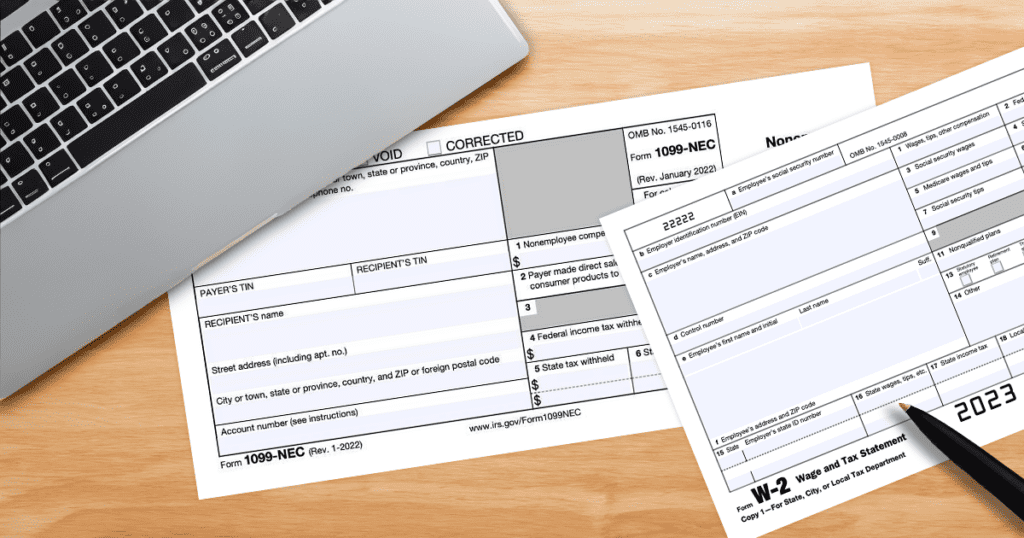In today’s working world, it’s vital to grasp the distinctions between “W2 vs. 1099,” whether you’re an employee or an employer. This article will clarify the main differences and offer insights to help you make informed choices for your business.
W2 Employee: The Conventional Path
Definition: A W2 employee is a vital part of a company’s workforce, hired for a specific job, with the employer having significant control over their work.
Taxation: When considering W2 vs. 1099, the fundamental difference lies in taxation. W2 employees have taxes withheld by their employers, covering federal and state income tax, Social Security, and Medicare. Employers also contribute to Social Security and Medicare taxes on behalf of employees.
Benefits: W2 employees typically enjoy a comprehensive benefits package, including health insurance, 401(k) retirement plans, paid leave (vacation, sick days, holidays), and workers’ compensation. Employers often contribute to these benefits, providing stability and security to employees.
Work Control: Employers exercise substantial control over W2 employees’ work, determining work hours, providing equipment, and directing daily tasks. This control ensures compliance with company policies and procedures.
Long-Term Commitment: W2 employment typically signifies a long-term commitment, with job security and opportunities for career advancement within the organization.
Pay Structure: W2 employees receive regular paychecks on predetermined schedules (weekly, bi-weekly, or monthly), ensuring a stable and predictable income.
Contract (1099) Labor: The Versatile Alternative
Definition: Contract labor, often referred to as 1099 work, allows individuals or businesses to hire independent contractors for specific projects or services.
Taxation: There are W2 vs. 1099 taxation differences here as well. Independent contractors are considered self-employed. They are responsible for handling their taxes, including federal and state income tax and self-employment tax (covering Social Security and Medicare contributions).
Benefits: Independent contractors typically do not receive traditional employee perks like health insurance or retirement plans. Contractors are responsible for their benefits, which can lead to higher compensation rates to offset the lack of assistance.
Work Control: Independent contractors enjoy greater freedom over their work. They provide their tools and equipment and have more flexibility regarding when, where, and how they complete tasks. While they may agree to project deadlines, contractors have more control.
Short-Term Commitment: Contract work is often project-based or short-term, offering flexibility in choosing projects and schedules.
Pay Structure: Clients pay independent contractors based on the terms of their contract, which can be hourly, per project, or on a retainer basis. Payment schedules vary based on the agreement.

W2 vs. 1099 – Key Considerations for Employers and Workers
For Employers:
- Cost: W2 employees generally come with higher overall costs due to benefits and taxes, while contractors can offer cost savings.
- Control: If you need more control over the work process, hiring W2 employees may be preferable.
- Flexibility: For short-term or project-specific needs, contract labor offers greater flexibility.
- Legal Compliance: Ensure proper worker classification to avoid legal issues and penalties.
For Workers:
- Stability: If job security, benefits, and a consistent income are your priorities, a W2 position might be more attractive.
- Flexibility: If you prefer autonomy, setting your rates, and choosing projects, contract work could be the better fit.
- Taxes: As an independent contractor, prepare to handle your taxes, including setting aside funds for tax payments.
In conclusion, whether you’re an employer seeking the right workforce structure for your business or a worker exploring the best fit for your career goals, the choice between W2 vs. 1099 (contract labor) hinges on a multitude of factors. These factors include financial considerations, work control preferences, flexibility needs, and legal obligations. By thoroughly assessing your specific circumstances and objectives, you can make an informed decision that aligns with your long-term success and satisfaction in the ever-changing employment landscape. If you’re still unsure, reach out to us here and one of our staff will be happy to sit down with you to discuss how we can help your small business flourish.
